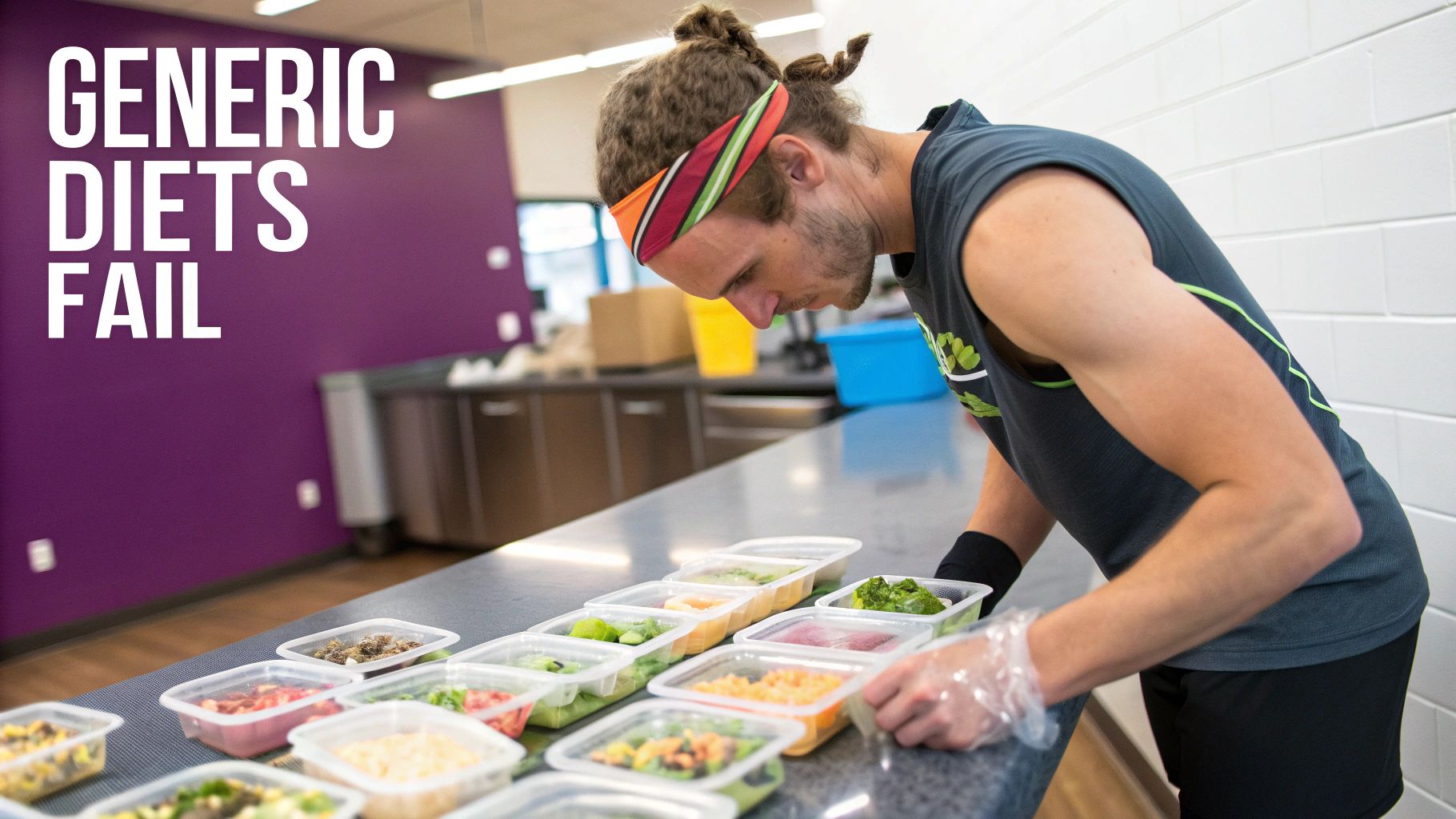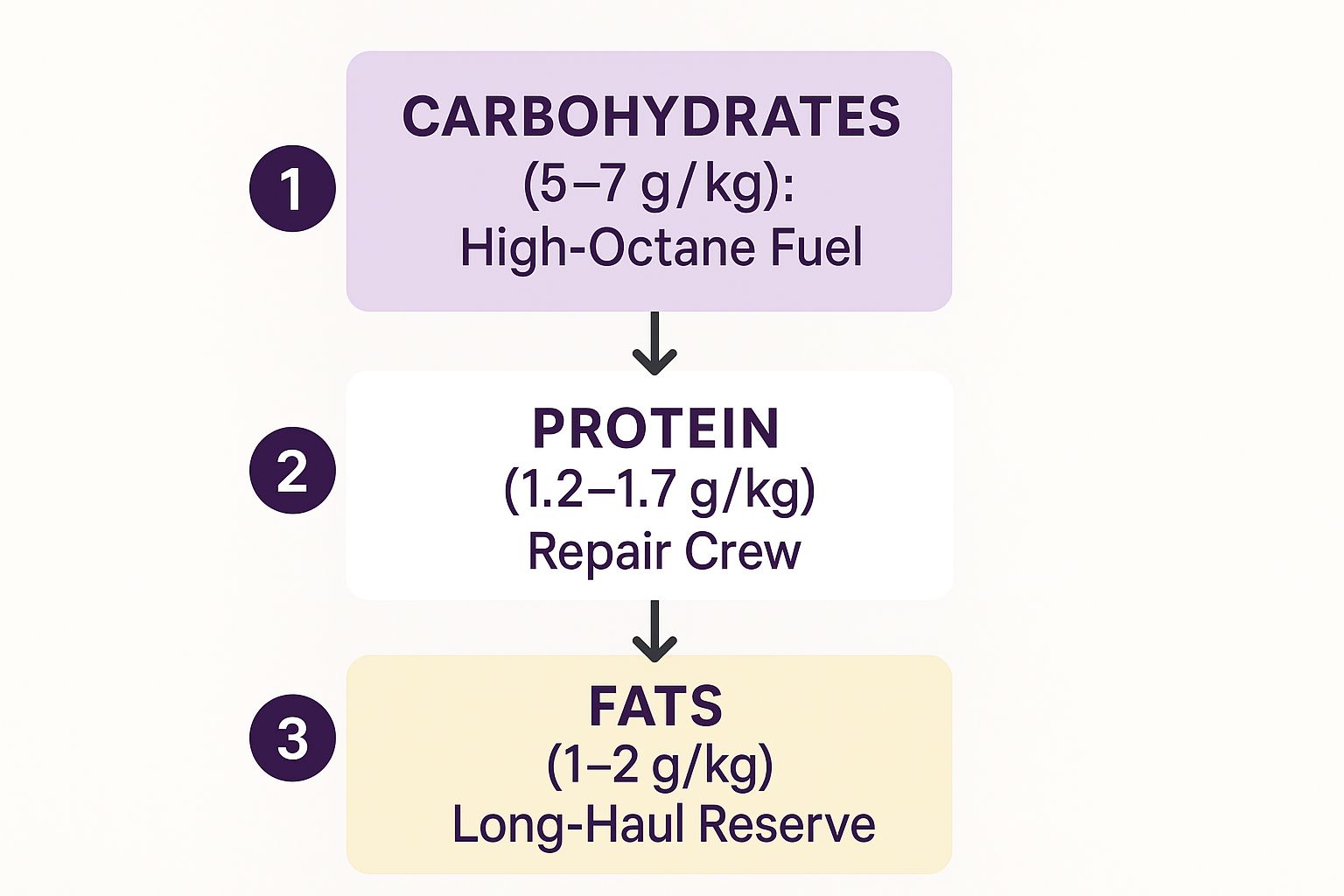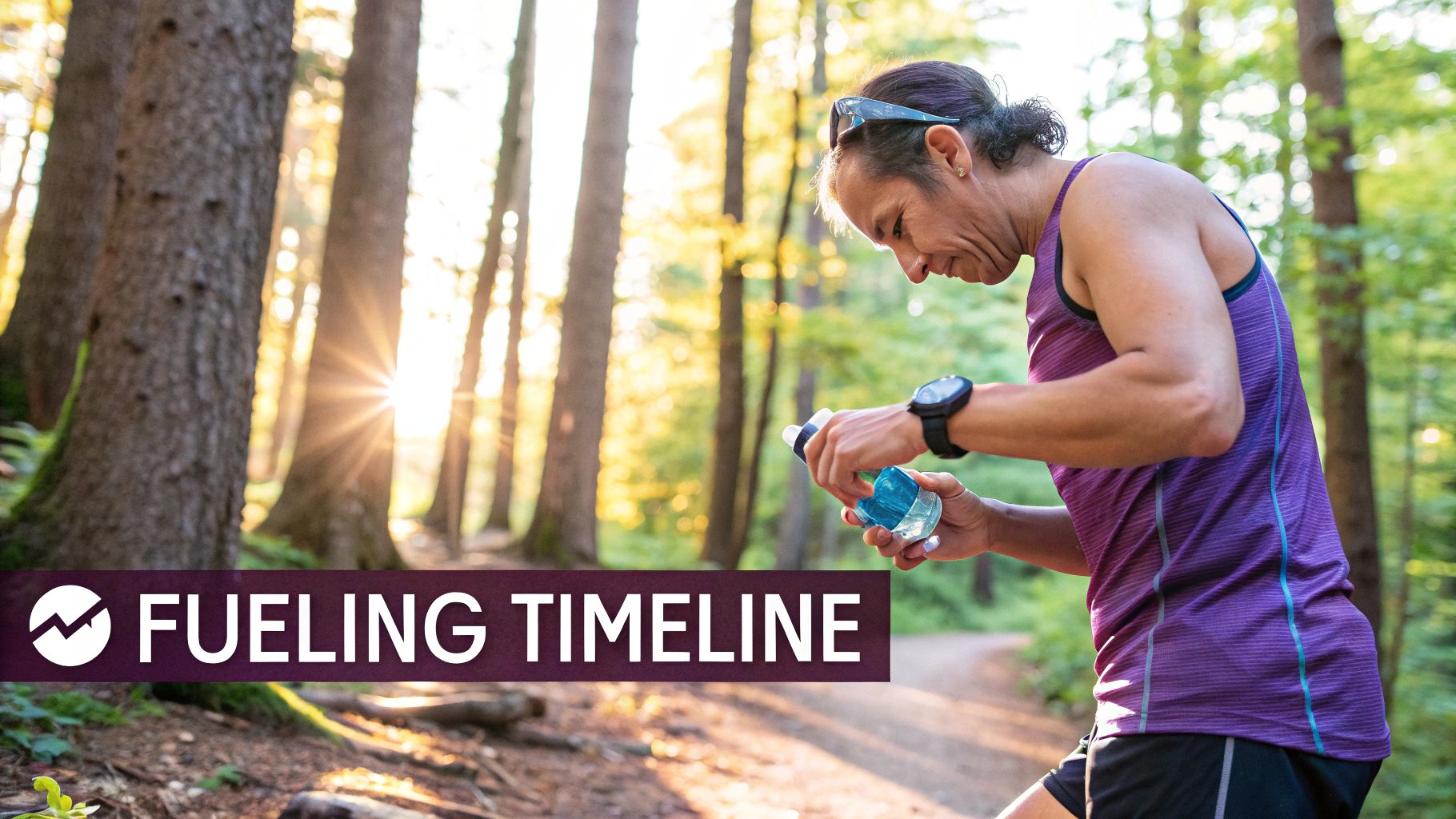
Sports Nutrition for Endurance Athletes
For an endurance athlete, sports nutrition isn't just about eating healthy. It's a strategic plan to fuel your body for long, grueling efforts.
This means getting the right macronutrients, nailing your hydration, and timing everything perfectly to maximize performance and bounce back faster.
Why Your Everyday Diet Won't Cut It
Think of your body like a high-performance race car. You wouldn't put regular unleaded in a Formula 1 engine and expect it to win, right? The same logic applies here. A standard "healthy" diet just doesn't provide the high-octane fuel required to handle the incredible stress of hours-long training sessions.
Running, cycling, or swimming for extended periods puts your body under immense metabolic strain. That kind of demand calls for a much more calculated approach to what you eat and when.

This guide is your playbook. We will dig into the specific diet and exercise habits that turn a good athlete into a great one.
The Four Pillars of Endurance Fueling
To build a nutrition strategy that works, you must focus on four key areas. They all work together, and if one is off, your performance will suffer.
- Macronutrients: This is your core fuel. Carbohydrates, protein, and fat each play a critical role. We'll break down how to balance them for immediate energy, long-lasting power, and muscle repair.
- Hydration and Electrolytes: Dehydration is the fastest way to kill a workout. It's not just about drinking water; you have to replace crucial minerals lost in sweat. Using targeted electrolyte powders can be a total game-changer for staying balanced.
- Nutrient Timing: When you eat is just as crucial as what you eat. We'll explore the critical fueling windows—before, during, and after exercise—to help you avoid hitting that dreaded wall.
- Strategic Supplementation: Food always comes first, but the right supplements provide a real edge. We’ll look at science-backed options from dietexerciseshop.com that can support your energy, endurance, and recovery.
The Science of Performance is Booming
The focus on nutrition details is part of a bigger picture. The global sports nutrition market was valued at around USD 58.72 billion in 2024 and is expected to climb to USD 104.65 billion by 2033.
This shows how serious athletes are about optimizing performance. You can find more market insights from IMARC Group highlighting this trend. By mastering these principles, you’re investing in your athletic potential.
Building Your High-Performance Fueling Plan
To dial in your nutrition, you have to start with the fundamentals: macronutrients. Carbs, protein, and fat are the specialist members of your performance crew. Getting the balance right is the foundation of smart fueling.
Carbohydrates are your high-octane fuel. They're the most easily accessible energy source your body has, essential for everything from a hard tempo run to a marathon finish line. Skimp on carbs, and you'll hit the wall.
Protein is your dedicated repair crew. Long workouts create tiny micro-tears in your muscle fibers. Protein delivers the amino acids needed to patch up that damage and rebuild tissue stronger.
Fats are your long-haul energy reserve. This slow-burning fuel is crucial for ultra-endurance efforts. Healthy fats also play a huge part in hormone production and taming inflammation.
Calculating Your Macronutrient Needs
How much of each macro do you need? It’s a personalized calculation based on your body weight and training intensity. The goal is to stop guessing and start fueling with precision.
This infographic breaks down the general daily targets for endurance athletes.

As you can see, carbohydrates make up the lion's share of an athlete's intake, followed by protein for repair, and then fats for sustained energy.
Let's see how this plays out in a real-world example.
Macros in Action: A Practical Example
Let's take a 70 kg (154 lb) marathon runner deep in their training block. Here’s what their daily targets might look like:
- Carbohydrates (High-Octane Fuel): At 8 g/kg, they'd need 560 grams of carbs. This keeps muscle glycogen stores full for demanding runs.
- Protein (Repair Crew): At 1.6 g/kg, the target is 112 grams of protein. This is critical for repairing muscle damage and adapting to heavy training.
- Fats (Long-Haul Reserve): At 1.2 g/kg, they'd eat around 84 grams of healthy fats to support overall health and provide slow-release energy.
Nailing these calculations is your first step. For a detailed walkthrough, check out our guide on how to calculate your macros.
The Role of Simple vs. Complex Carbs
Not all carbs are the same. When you eat simple versus complex carbohydrates can make or break your performance.
Simple carbohydrates, found in sports gels, chews, and fruit, digest incredibly fast. They give you a quick spike in blood sugar, which is exactly what you want for immediate energy during a workout or to rapidly restock stores right after.
Complex carbohydrates, found in foods like oatmeal, brown rice, and sweet potatoes, digest slowly. They provide a steady, sustained release of energy, making them perfect for your main meals.
Why Quality Protein Matters for Recovery
Hitting your daily protein number is non-negotiable for proper recovery. During workouts lasting over an hour, taking in 30-60 grams of carbohydrates per hour is vital for holding off fatigue. Afterward, consuming 20-40 grams of protein is exactly what your body needs to kickstart muscle repair.
A high-quality protein powder can be a game-changer. After a brutal session, a simple post-workout shake is an easy-to-digest, convenient way to deliver the protein your muscles need. It's often easier than eating a big meal.
For the perfect recovery cocktail, mix a scoop of protein powder with a source of simple carbs like a banana. This combo rapidly refills your depleted glycogen stores while delivering amino acids for muscle synthesis. This simple habit can dramatically reduce soreness.
Mastering Your Fueling and Recovery Timeline
In endurance sports, when you eat is just as crucial as what you eat. Getting your nutrient timing right gives you the power to conquer tough workouts and bounce back stronger. It all breaks down into three critical windows: before, during, and after your session.
Think of your energy reserves like a phone battery. You wouldn't start a long road trip with a 10% charge. The same logic applies to your body. You need to top off your glycogen stores before a long workout.

Fueling Before You Go
About two hours before you head out, load up on easily digestible carbohydrates. This gives your body time to convert the food into ready-to-use fuel without causing stomach trouble.
Avoid heavy foods loaded with fat, fiber, or a ton of protein right before a workout. These slow digestion and can lead to cramps, bloating, and a heavy feeling in your gut.
Pre-Workout Fueling Goal: Consume approximately 1 gram of carbohydrate per kilogram of body weight about two hours before your session. For a 70kg (154 lb) athlete, that's around 70 grams of carbs.
This simple approach ensures your muscle glycogen is full, giving you instant energy from the start.
The Secret to Sustained Energy Intra-Workout
If your workout lasts longer than 90 minutes, fueling during the session is non-negotiable. This is your best defense against "bonking" or hitting the wall.
To keep energy steady, you need a constant stream of simple carbohydrates. This is why products like energy gels and chews are a game-changer. They're designed for quick absorption, delivering a fast hit of glucose to your muscles.
The supplement segment accounted for 39.4% of global sports nutrition revenue in 2023, a value of USD 45.24 billion. You can find more insights on the sports nutrition market to see how essential these products are.
Here’s a starting point for fueling on the go:
- Target: Aim for 30-60 grams of carbohydrates per hour.
- Timing: Start fueling 45-60 minutes into your workout, and continue every 30-45 minutes.
- Hydration: Always pair your fuel with fluids, especially drinks with electrolytes.
Maximizing Recovery Post-Workout
The moment you stop, your recovery begins. The first 30-60 minutes after you finish is the "recovery window." Your muscles are primed to soak up nutrients and kickstart repair.
Your mission is twofold: restock empty glycogen tanks and give your muscles the protein they need to repair damage. Skipping this step leads to lingering soreness and fatigue.
Focus on a specific nutrient ratio for this window.
- The Golden Ratio: The perfect post-workout meal or shake has a 3:1 or 4:1 ratio of carbohydrates to protein.
- Carbohydrate's Role: Carbs immediately refill your muscle glycogen.
- Protein's Role: Protein delivers amino acids for muscle protein synthesis—the rebuilding process.
A recovery shake is one of the easiest ways to hit these targets. For more ideas, check our guide on the best post-workout recovery foods.
Endurance Athlete Fueling Timeline
| Timing | Goal | What to Consume | Product Example |
|---|---|---|---|
| 2 Hours Before | Top off glycogen stores | Easy-to-digest carbs, minimal fat/fiber | Oatmeal with banana, toast with jam |
| During (every 45-60 min) | Maintain blood glucose levels | 30-60g simple carbs per hour | Energy gels, chews, sports drinks |
| 0-60 Mins After | Replenish glycogen & repair muscle | 3:1 or 4:1 Carb-to-Protein ratio | Recovery shake with whey protein & fruit |
By getting strategic with what and when you eat, you create a powerful cycle of peak performance and rapid recovery.
The Unsung Hero of Endurance Performance
We talk a lot about carbs, but hydration can make or break your performance. Getting your fluids and electrolytes dialed in is one of the most powerful things you can do.
Dehydration is the silent killer of a good race day. Losing just 2% of your body weight in sweat can cause your performance to nosedive.

As you get dehydrated, your blood volume drops. This makes your blood thicker, forcing your heart to work overtime to get oxygen to your muscles. Your heart rate skyrockets, your brain gets foggy, and every step feels harder.
Beyond Water: The Role of Electrolytes
Hydration isn't just about chugging plain water. When you sweat, you lose critical minerals called electrolytes. They keep your muscles firing and your internal systems running smoothly.
For endurance athletes, three electrolytes are particularly important:
- Sodium: The main electrolyte lost in sweat, it helps your body absorb and hold onto water.
- Potassium: Works with sodium to maintain fluid balance and ward off muscle cramps.
- Magnesium: Involved in hundreds of processes, including energy production and muscle function.
Drinking only plain water during a long workout can backfire. It can dilute your remaining electrolytes, leading to a dangerous condition called hyponatremia. That’s why you need to replace what you're losing.
Calculate Your Personal Sweat Rate
There’s no magic number for how much you should drink. The only way to know your needs is to figure out your personal sweat rate.
Here’s how to do it:
- Weigh In: Before a one-hour workout, weigh yourself with minimal clothing.
- Train for an Hour: Go for a run or ride in race-like conditions. Track how much fluid you drink.
- Weigh Out: After your workout, towel off and weigh yourself again in the same clothes.
-
Do the Math:
- Subtract your post-workout weight from your pre-workout weight.
- Convert that weight loss to ounces or milliliters (1 lb = 16 oz).
- Add the amount of fluid you drank.
- The final number is your hourly sweat rate.
Example: You lose 1 lb (16 oz) during your run and drank a 16 oz bottle of water. Your total fluid loss is 16 oz + 16 oz = 32 oz (about 950 ml) per hour. That's your personal hydration target.
Why Electrolyte Powders Are a Game-Changer
Once you know your fluid loss, you must replace it effectively. This is where electrolyte powders and tablets are non-negotiable.
These products are designed to give you the right mix of sodium, potassium, and other key minerals in a form your body can absorb quickly.
Mixing an electrolyte powder into your bottle tackles hydration and electrolyte replacement at the same time. This strategy is crucial for maintaining fluid balance, stopping cramps, and keeping performance strong.
Strategic Supplementation for Endurance Athletes
Think of your diet as the engine that drives your performance. Supplements are the high-octane additives. They don’t replace fuel but fine-tune the engine, helping it run more efficiently when you’re pushing its limits.
This isn’t about finding a magic pill. It’s about being smart and strategic, filling specific gaps that are tough to cover with food alone. A well-thought-out supplement plan from dietexerciseshop.com is a key piece of a complete sports nutrition for endurance athletes strategy.
The Micronutrient Foundation
Before performance-boosting supplements, you must get the basics right. Micronutrients—vitamins and minerals—are the unsung heroes of energy production.
Two of the biggest players are:
- Iron: This mineral builds hemoglobin, which carries oxygen to your muscles. Low iron leads to fatigue and poor performance.
- B Vitamins: This family of vitamins, including B6 and B12, helps your body convert food into usable energy.
A food-first approach is always best. You can find these nutrients in leafy greens, red meat, and fortified grains. If you’re feeling constantly wiped out despite eating well, blood work can check for deficiencies.
Creatine: Powering Your Climbs and Sprints
Most people associate creatine with bodybuilding, but it's also effective for endurance athletes. Creatine helps recycle ATP, the fuel for short, explosive efforts.
What does that mean for you? An extra gear when you need it most.
- Attacking a steep hill.
- Surging to break away.
- An all-out sprint to the finish.
Just 3-5 grams a day is enough. Our high-quality creatine is a fantastic way to support the strength and interval training that makes you a faster endurance athlete.
Beta-Alanine: The Fatigue Fighter
The searing muscle burn you feel during a tough effort is lactic acid. Beta-alanine helps your body produce carnosine, a compound that buffers that acid.
By pushing back that burn, beta-alanine lets you hold a higher intensity for longer. This is huge for events where you're at your lactate threshold.
For endurance athletes, buffering lactic acid is a significant advantage. It can be the difference between holding your pace on a final climb and backing off.
Take it consistently for a few weeks to build up muscle carnosine stores. Check out our premium beta-alanine to add this fatigue-fighting tool to your arsenal.
BCAAs: For Better Recovery
Branched-Chain Amino Acids (BCAAs) are a trio of essential amino acids: leucine, isoleucine, and valine. They can be used for energy directly by your muscles.
This makes them useful for endurance athletes in a couple of key ways:
- Less Muscle Soreness: Sipping on BCAAs before or during a long session can help reduce muscle damage, meaning less soreness the next day.
- Faster Recovery: They provide direct building blocks for muscle repair, helping you bounce back quicker.
By cutting down on muscle breakdown, BCAAs help you stay consistent with your training. If you're looking to ease soreness and train sooner, adding BCAAs to your plan is a smart move.
Building Your Personal Nutrition Blueprint
There's no single "perfect" nutrition plan. The best plan is the one built for you, by you, through trial, error, and listening to your body.
Think of these principles as raw materials for your personal fueling strategy. Your body is the real coach. How you feel on a long run or how you bounce back the next day is the data that matters most.
Your Path to Peak Performance
The real secret to nailing your nutrition is consistency. Stick with a plan long enough to see if it’s working.
- Test Everything in Training: Never experiment on race day. Use long training sessions as your laboratory to figure out what your gut can handle.
- Keep a Simple Log: Jot down what you ate, when, and how you felt. Over time, you’ll see connections between your fuel and performance.
- Adjust and Refine: Hitting a wall? You might need more carbs. Getting cramps? It could be an electrolyte issue. Making small, informed tweaks is how you perfect your plan.
Your body is constantly adapting. A rigid nutrition plan will eventually fail. The goal is to create a flexible approach that can evolve as you get fitter.
When you’re ready to put these principles into practice, explore the full range of products we’ve designed to help you hit your goals. For more practical tips, subscribe to the Diet & Exercise YouTube channel.
Answering Your Biggest Endurance Nutrition Questions
Figuring out how to fuel can feel like a maze. Let's tackle some of the most common questions to give you clarity and confidence.
How Do I Avoid Stomach Issues During a Race?
Gut problems can derail a race. The golden rule is: "train your gut" just as seriously as you train your legs and lungs.
Never try something new on race day. Use your long training runs as a dress rehearsal with the exact same gels, chews, and drinks you plan to use. This gives your digestive system time to adapt.
In the 24 hours before the start, steer clear of anything high in fiber or fat.
Think simple. Easily digestible carbs are your best bet. Sip fluids consistently instead of chugging them to prevent cramps and bloating.
Should I Carb-Load Before Every Long Workout?
Carb-loading is a great strategy, but it's for a specific job. Save it for big "A" races lasting over 90 minutes, like a marathon or century ride. The goal is to spend 2-3 days upping your carb intake to max out muscle glycogen stores.
For a typical weekend long run, a full carb-load is overkill. Just eat a consistently high-carb diet and have a good carb-rich meal a few hours before you head out.
Want more practical fueling tips? Check out the Diet & Exercise YouTube channel for great visual guides.
Can I Follow a Keto Diet as an Endurance Athlete?
You can, but it comes with serious trade-offs. A ketogenic diet pushes your body to become "fat-adapted," meaning it gets good at burning fat for energy.
This works for long, slow, low-intensity efforts. The problem is when you need to dig deep. High-intensity moments like a sprint finish or a sharp climb depend on carbohydrates as a fast-acting fuel source.
Many athletes find that on keto, they lose that top gear. It’s a personal choice that might not be best for competitive performance.
At Diet and Exercise, we’re here to support your entire fitness journey. Our unique Workout Coloring Book is a perfect way to unwind and stay connected to your goals on your well-deserved rest days.
